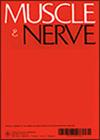双倍拷贝 RFC1 重复扩增患者周围神经病变的电生理特征
IF 2.8
3区 医学
Q2 CLINICAL NEUROLOGY
引用次数: 0
摘要
导言/目的小脑共济失调、神经病、前庭反射综合征(CANVAS)是由 RFC1 扩张引起的。RFC1扩张症患者会出现感觉神经病、多发性神经病以及运动神经、自主神经和颅神经受累。我们的目的是通过多模态电生理检查来描述 RFC1 扩大症患者的电诊断特征。方法对 35 名中位年龄为 70 岁、RFC1 基因病理性双倍重复扩增的患者进行了运动和感觉神经传导、桡侧屈肌(FCR)和比目鱼肌 H-反射、眨眼反射、皮肤电化学传导、交感神经皮肤反应(SSR)和深呼吸时的心率变异性(HRV)测试。30 名患者的远端运动幅度正常,5 名患者的腿部运动幅度减弱。30 名患者的双侧远端感觉振幅减弱,且与长度无关。传导速度正常。19/20名患者的跟腱H反射异常,其中7名患者的跟腱反射得以保留。13/14例患者的FCR H反射消失或振幅减小。4/19 名患者的眨眼反射异常:两名患者的 R1 潜伏期和另外两名患者的 R2 潜伏期出现异常。31例患者中有14例(45%)至少有一项自律神经系统测试结果异常,包括ESC(12/31)、SSR(5/14)或心率变异(6/19)。小神经纤维和脑干神经元受累的情况较少。本文章由计算机程序翻译,如有差异,请以英文原文为准。
Electrophysiological features of the peripheral neuropathy in patients with pathologic biallelic RFC1 repeat expansions
Introduction/AimsCerebellar ataxia, neuropathy, vestibular areflexia syndrome (CANVAS) is caused by RFC1 expansions. Sensory neuronopathy, polyneuropathy, and involvement of motor, autonomic, and cranial nerves have all been described with RFC1 expansions. We aimed to describe the electrodiagnostic features of patients with RFC1 expansions through multimodal electrophysiological investigations.MethodsThirty‐five patients, with a median age of 70 years, and pathologic biallelic repeat expansions in the RFC1 gene, were tested for motor and sensory nerve conduction, flexor carpi radialis (FCR) and soleus H‐reflexes, blink reflex, electrochemical skin conductance, sympathetic skin response (SSR), and heart rate variability with deep breathing (HRV).ResultsOnly 16 patients (46%) exhibited the full clinical CANVAS spectrum. Distal motor amplitudes were normal in 30 patients and reduced in the legs of five patients. Distal sensory amplitudes were bilaterally reduced in a non‐length dependent manner in 30 patients. Conduction velocities were normal. Soleus H‐reflexes were abnormal in 19/20 patients of whom seven had preserved Achilles reflexes. FCR H‐reflexes were absent or decreased in amplitude in 13/14 patients. Blink reflex was abnormal in 4/19 patients: R1 latencies for two patients and R2 latencies for two others. Fourteen out of 31 patients (45%) had abnormal results in at least one autonomic nervous system test, either for ESC (12/31), SSR (5/14), or HRV (6/19).DiscussionLess than half of the patients with RFC1 expansions exhibited the full clinical CANVAS spectrum, but nearly all exhibited typical sensory neuronopathy and abnormal H‐reflexes. Involvement of small nerve fibers and brainstem neurons was less common.
求助全文
通过发布文献求助,成功后即可免费获取论文全文。
去求助
来源期刊

Muscle & Nerve
医学-临床神经学
CiteScore
6.40
自引率
5.90%
发文量
287
审稿时长
3-6 weeks
期刊介绍:
Muscle & Nerve is an international and interdisciplinary publication of original contributions, in both health and disease, concerning studies of the muscle, the neuromuscular junction, the peripheral motor, sensory and autonomic neurons, and the central nervous system where the behavior of the peripheral nervous system is clarified. Appearing monthly, Muscle & Nerve publishes clinical studies and clinically relevant research reports in the fields of anatomy, biochemistry, cell biology, electrophysiology and electrodiagnosis, epidemiology, genetics, immunology, pathology, pharmacology, physiology, toxicology, and virology. The Journal welcomes articles and reports on basic clinical electrophysiology and electrodiagnosis. We expedite some papers dealing with timely topics to keep up with the fast-moving pace of science, based on the referees'' recommendation.
 求助内容:
求助内容: 应助结果提醒方式:
应助结果提醒方式:


